
 |
||||||
|
GAY
FILM REVIEWS BY MICHAEL D. KLEMM
|
||||||
|
The
Killing MGM
Home Video. Director:
Screenplay:
Originally
Rated X |
The
Madness Of Dame George
The Killing Of Sister George (1968) is often spoken of in the same breath with The Boys In The Band (1970) because both share a certain notoriety for being hysterically negative representations of queers on the silver screen. I am embarrassed to say that, until last night, I knew the film only by its reputation. It took me a long time but I'm finally able to join the debate. |
 This
is a difficult film to review as it was, in some ways, groundbreaking while
also being overly sensationalistic at the same time. Discussing this film
will involve spoilers, so be forewarned. The
Killing Of Sister George was originally a play by Frank Marcus.
The original 1964 production, starring Beryl Reid, premiered in London's
West End and opened on Broadway two years later with most of its cast intact.
In 1968, director Robert Aldrich brought it to the screen. Aldrich is best
known for having directed Bette Davis and Joan Crawford in that Grand Guignol
camp classic, Whatever Happened To Baby Jane? in 1962. Baby Jane's
screenwriter handled the adaptation. This
is a difficult film to review as it was, in some ways, groundbreaking while
also being overly sensationalistic at the same time. Discussing this film
will involve spoilers, so be forewarned. The
Killing Of Sister George was originally a play by Frank Marcus.
The original 1964 production, starring Beryl Reid, premiered in London's
West End and opened on Broadway two years later with most of its cast intact.
In 1968, director Robert Aldrich brought it to the screen. Aldrich is best
known for having directed Bette Davis and Joan Crawford in that Grand Guignol
camp classic, Whatever Happened To Baby Jane? in 1962. Baby Jane's
screenwriter handled the adaptation. |
|
|
|
|
| Fittingly,
she is known to everyone as "George." Because she goes by that name throughout
the film, I will do the same in this essay. |
|
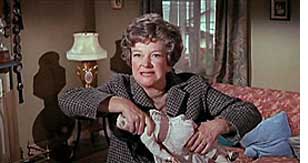 George
lives with Alice "Childie" McNaught (Susannah York), a younger and child-like
woman who enjoys playing with her large collection of Victorian dolls. Childie
bears the brunt of George's often drunken anger. George is verbally and
sometimes physically abusive, and their relationship dynamic fuses the butch-femme
and the master-slave. During a truly repugnant scene, George forces Childie
to eat her cigar. Childie does so in a tight close-up; at first her face
registers disgust but then morphs into an expression of sexual rapture.
George often threatens to rip apart Childie's favorite doll. She repeatedly
accuses her younger lover of infidelity. When Childie screams that "Not
all of the girls are raving, bloody lesbians, you know," George replies,
"That is a misfortune that I am well aware of." George
lives with Alice "Childie" McNaught (Susannah York), a younger and child-like
woman who enjoys playing with her large collection of Victorian dolls. Childie
bears the brunt of George's often drunken anger. George is verbally and
sometimes physically abusive, and their relationship dynamic fuses the butch-femme
and the master-slave. During a truly repugnant scene, George forces Childie
to eat her cigar. Childie does so in a tight close-up; at first her face
registers disgust but then morphs into an expression of sexual rapture.
George often threatens to rip apart Childie's favorite doll. She repeatedly
accuses her younger lover of infidelity. When Childie screams that "Not
all of the girls are raving, bloody lesbians, you know," George replies,
"That is a misfortune that I am well aware of." |
|
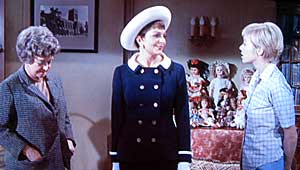 The
"killing" in the title is not meant to be taken literally. The producers
of Applehurst have decided to kill off the character of Sister George.
The actress is becoming a liability; George has walked off the set, her
public drunkenness is becoming more and more scandalous, and the incident
with the nuns provides the icing on the cake. This bad news is delivered
by a network executive named Mercy Croft (Coral Browne) who slowly insinuates
her way into George and Childie's lives. She is the classic, well-dressed,
predatory lesbian that began to appear in many 1960s films, and she has
set her eyes on Childie. The
"killing" in the title is not meant to be taken literally. The producers
of Applehurst have decided to kill off the character of Sister George.
The actress is becoming a liability; George has walked off the set, her
public drunkenness is becoming more and more scandalous, and the incident
with the nuns provides the icing on the cake. This bad news is delivered
by a network executive named Mercy Croft (Coral Browne) who slowly insinuates
her way into George and Childie's lives. She is the classic, well-dressed,
predatory lesbian that began to appear in many 1960s films, and she has
set her eyes on Childie. |
|
| Okay; this is a film from the 1960s featuring abusive and predatory lesbians and it's directed by the man who gave the world Whatever Happened To Baby Jane? and Hush, Hush Sweet Charlotte. Sounds like a groundbreaking film along the lines of Desert Hearts, doesn't it? | |
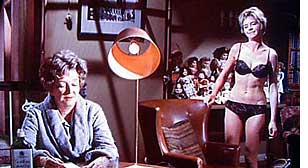 This
is where writing about this film, from a standpoint four decades later,
becomes a bit problematic. The story, itself, is a study in dysfunction
that resembles a strange hybrid of Edward Albee, Tennessee
Williams and Joe
Orton. The playwright meant it as a Pinter-esque farce and the play
was originally billed as a comedy. The Killing
Of Sister George is mildly successful on these levels, but
then one has to consider that pesky lesbian issue. If this was Who's
Afraid Of Virginia Woolf?, and the film was about abusive heterosexual
couples, we would not be having this discussion right now. But there weren't
a lot of films about lesbians on the silver screen and the audiences who
did see The Killing Of Sister George
in 1968 were presented with a very unflattering portrait. This
is where writing about this film, from a standpoint four decades later,
becomes a bit problematic. The story, itself, is a study in dysfunction
that resembles a strange hybrid of Edward Albee, Tennessee
Williams and Joe
Orton. The playwright meant it as a Pinter-esque farce and the play
was originally billed as a comedy. The Killing
Of Sister George is mildly successful on these levels, but
then one has to consider that pesky lesbian issue. If this was Who's
Afraid Of Virginia Woolf?, and the film was about abusive heterosexual
couples, we would not be having this discussion right now. But there weren't
a lot of films about lesbians on the silver screen and the audiences who
did see The Killing Of Sister George
in 1968 were presented with a very unflattering portrait. |
|
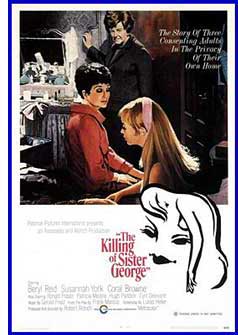 In
its defense, let us consider George. Unlike the whiners in The
Boys In The Band, George is hardly a self-loathing dyke. On the
contrary. She might not be the nicest woman in the world, but she is living
her life on her own terms and doesn't care what anyone else thinks. George
is boisterous, she dresses in masculine attire, she says and does what she
wants and the rest of the world can fuck off. She lives openly with Childie
and it seems fairly obvious that everyone at the television station knows
that they are more than just "flatmates." Even her S&M games with her partner
can be viewed as an extension of her role playing on televsion. The decision
to kill off Sister George undoubtedly stems, at least in part, from the
gay actress' refusal to bury her real identity and remain invisible like
a good little girl (at one point George even calls herself a "bad boy"). In
its defense, let us consider George. Unlike the whiners in The
Boys In The Band, George is hardly a self-loathing dyke. On the
contrary. She might not be the nicest woman in the world, but she is living
her life on her own terms and doesn't care what anyone else thinks. George
is boisterous, she dresses in masculine attire, she says and does what she
wants and the rest of the world can fuck off. She lives openly with Childie
and it seems fairly obvious that everyone at the television station knows
that they are more than just "flatmates." Even her S&M games with her partner
can be viewed as an extension of her role playing on televsion. The decision
to kill off Sister George undoubtedly stems, at least in part, from the
gay actress' refusal to bury her real identity and remain invisible like
a good little girl (at one point George even calls herself a "bad boy").
|
|
 George's
downfall becomes even more humiliating when, at a network party, her visibility
is further compromised when she is offered a new part in a children's television
show in which she would play Clarabelle the Cow. Learning that she will
be a "flawed but credible cow" (because "otherwise children wouldn't believe
in her") does nothing to assuage her anger which she takes out on everyone,
including her partner. Childie has finally had enough and she responds to
Mercy's blatant advances and leaves with her. The film ends with George
wandering through the dark television studio, where she discovers that even
her character's coffin is fake, and begins to smash everything in sight.
Finally, she sits down on a bench and begins to moo - a wail of such despair
that it sends chills down the viewer's spine. While George may seem monstrous
at times, she ultimately generates the most sympathy and becomes the most
tragic of all the characters in the film. George's
downfall becomes even more humiliating when, at a network party, her visibility
is further compromised when she is offered a new part in a children's television
show in which she would play Clarabelle the Cow. Learning that she will
be a "flawed but credible cow" (because "otherwise children wouldn't believe
in her") does nothing to assuage her anger which she takes out on everyone,
including her partner. Childie has finally had enough and she responds to
Mercy's blatant advances and leaves with her. The film ends with George
wandering through the dark television studio, where she discovers that even
her character's coffin is fake, and begins to smash everything in sight.
Finally, she sits down on a bench and begins to moo - a wail of such despair
that it sends chills down the viewer's spine. While George may seem monstrous
at times, she ultimately generates the most sympathy and becomes the most
tragic of all the characters in the film. |
|
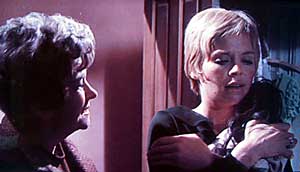 She
is also the funniest. Beryl Reid is often a hoot as George and watching
her chew the scenery (when she isn't abusing her partner) is a delight.
She is privileged with most of the best lines. Sister George's motorbike
was the actress' idea (surprise surprise) and, when Mercy innocently remarks
that she always looks so cheerful on the bike, George says, "You'd look
cheerful too with 50 cubic centimeters throbbing away between your legs." She
is also the funniest. Beryl Reid is often a hoot as George and watching
her chew the scenery (when she isn't abusing her partner) is a delight.
She is privileged with most of the best lines. Sister George's motorbike
was the actress' idea (surprise surprise) and, when Mercy innocently remarks
that she always looks so cheerful on the bike, George says, "You'd look
cheerful too with 50 cubic centimeters throbbing away between your legs." |
|
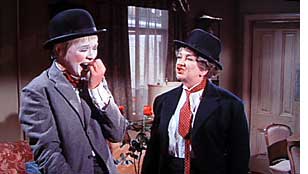 There
is also a wonderful scene in which George and Childie dress as Laurel and
Hardy and attend a costume ball at the local lesbian bar. This was filmed
at the legendary Gateways Club in London's Chelsea district and most of
the bar's regulars were featured as extras and can be seen dancing in the
finished film. Despite the movie's depiction of dysfunctional dykes,
The Killing Of Sister George at least offers a filmic record
of history's longest lasting lesbian bar. (On the downside, one of the extras
famously lost her job when her employer recognized her in a publicity still.) There
is also a wonderful scene in which George and Childie dress as Laurel and
Hardy and attend a costume ball at the local lesbian bar. This was filmed
at the legendary Gateways Club in London's Chelsea district and most of
the bar's regulars were featured as extras and can be seen dancing in the
finished film. Despite the movie's depiction of dysfunctional dykes,
The Killing Of Sister George at least offers a filmic record
of history's longest lasting lesbian bar. (On the downside, one of the extras
famously lost her job when her employer recognized her in a publicity still.) |
|
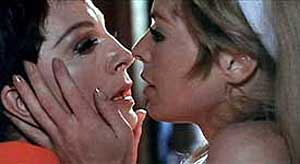 The
Killing Of Sister George
was not the first mainstream film to feature lesbians, but it is one of
the first films in which the dreaded L word was uttered. It is also one
of the first films to be rated X under the newly formed Motion Picture Code.
This was due to a very explicit (for its day) scene wherein Mercy seduces
the distraught Childie. This scene does not occur in the original
play, and it is difficult to discern whether or not the director's intentions
were noble or simply prurient. Aldrich knew the value of showmanship and
perhaps, like fellow director Otto Preminger, was just pushing the envelope
for the mere sake of doing so. The scene itself seems designed to shock.
It lasts for about three minutes and features kissing, nipple play and extended
close-ups of Childie's orgasm. What could have been the decade's most groundbreaking
scene of Sapphic passion is rendered almost clinical and emotionless by
melodramatic music that would have been a better fit in one of Roger Corman's
Edgar Allen Poe films. The
Killing Of Sister George
was not the first mainstream film to feature lesbians, but it is one of
the first films in which the dreaded L word was uttered. It is also one
of the first films to be rated X under the newly formed Motion Picture Code.
This was due to a very explicit (for its day) scene wherein Mercy seduces
the distraught Childie. This scene does not occur in the original
play, and it is difficult to discern whether or not the director's intentions
were noble or simply prurient. Aldrich knew the value of showmanship and
perhaps, like fellow director Otto Preminger, was just pushing the envelope
for the mere sake of doing so. The scene itself seems designed to shock.
It lasts for about three minutes and features kissing, nipple play and extended
close-ups of Childie's orgasm. What could have been the decade's most groundbreaking
scene of Sapphic passion is rendered almost clinical and emotionless by
melodramatic music that would have been a better fit in one of Roger Corman's
Edgar Allen Poe films. |
|
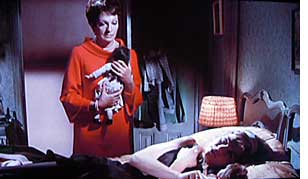 It
is unfortunate, but the first major film to really explore a lesbian
relationship was executed by clueless straight men. It is probably a given
that Aldrich and company weren't concerned with giving the world's lesbians
a movie that they could embrace and call their own. (The fact that Aldrich
also directed, ten years later, Joseph Wambaugh's extremely homophobic cop
"comedy," The Choirboys, also gives this reviewer pause.) While Aldrich
should probably be commended for "bravely" tackling the subject matter,
did he have to do so in such a grotesque manner? George is not a far cry
from Bette Davis' Baby Jane Hudson, and Mercy is a prime example of the
viperish lipstick lesbian that began to appear as villians in many of the
decade's movies. The only way that Childie differs from the other sex kittens
of the more kitschy films of the period is that she prefers the company
of women. It
is unfortunate, but the first major film to really explore a lesbian
relationship was executed by clueless straight men. It is probably a given
that Aldrich and company weren't concerned with giving the world's lesbians
a movie that they could embrace and call their own. (The fact that Aldrich
also directed, ten years later, Joseph Wambaugh's extremely homophobic cop
"comedy," The Choirboys, also gives this reviewer pause.) While Aldrich
should probably be commended for "bravely" tackling the subject matter,
did he have to do so in such a grotesque manner? George is not a far cry
from Bette Davis' Baby Jane Hudson, and Mercy is a prime example of the
viperish lipstick lesbian that began to appear as villians in many of the
decade's movies. The only way that Childie differs from the other sex kittens
of the more kitschy films of the period is that she prefers the company
of women. |
|
 Forgetting
for a moment the entire issue of a filmmaker's responsibility towards portions
of his audience, how does the Aldrich adaptation fare as cinema?
As far as depicting more adult subject matter in 60s cinema is concerned,
The Killing Of Sister George
is probably one of the era's unsung films (John
Schlesinger's also X rated Midnight Cowboy was still another
year away). Marcus' play was opened up considerably (the original took place
entirely in their London flat) and Sister George's soap opera was changed
from a radio to a television program. The ladies' cluttered apartment is
appropriately claustrophobic and becomes a character in itself. The acting
is terrific. Elements such as the all-girl band playing in the Gateways
Club hilariously date the movie. Much of the background score also dates
the film; the music, in fact, ruins George's climactic primal wail in the
deserted television studio. As stated earlier, the controversial sex scene
seemed designed more to shock and to titillate than to celebrate women in
love. Forgetting
for a moment the entire issue of a filmmaker's responsibility towards portions
of his audience, how does the Aldrich adaptation fare as cinema?
As far as depicting more adult subject matter in 60s cinema is concerned,
The Killing Of Sister George
is probably one of the era's unsung films (John
Schlesinger's also X rated Midnight Cowboy was still another
year away). Marcus' play was opened up considerably (the original took place
entirely in their London flat) and Sister George's soap opera was changed
from a radio to a television program. The ladies' cluttered apartment is
appropriately claustrophobic and becomes a character in itself. The acting
is terrific. Elements such as the all-girl band playing in the Gateways
Club hilariously date the movie. Much of the background score also dates
the film; the music, in fact, ruins George's climactic primal wail in the
deserted television studio. As stated earlier, the controversial sex scene
seemed designed more to shock and to titillate than to celebrate women in
love. |
|
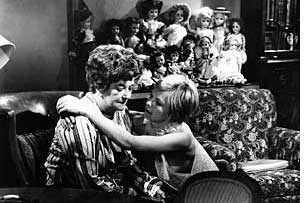 As
a gay man, my history with The Boys In The
Band goes back many years and I will not try to guess how most of
my gay sisters view The Killing Of Sister George.
My own final verdict? The film makes for some very unpleasant viewing
but it isn't a complete washout. As an edgy play/film in the Pinter/Orton
tradition, and as a satire on television, there is much to commend. As cinema,
it is an interesting curio that perhaps deserves a little more respect than
it is generally accorded. As positive, groundbreaking lesbian cinema it
is a resounding and often ludicrous failure. But at least George isn't killed
by a tree falling on her like poor Sandy Dennis in the previous year's The
Fox. As
a gay man, my history with The Boys In The
Band goes back many years and I will not try to guess how most of
my gay sisters view The Killing Of Sister George.
My own final verdict? The film makes for some very unpleasant viewing
but it isn't a complete washout. As an edgy play/film in the Pinter/Orton
tradition, and as a satire on television, there is much to commend. As cinema,
it is an interesting curio that perhaps deserves a little more respect than
it is generally accorded. As positive, groundbreaking lesbian cinema it
is a resounding and often ludicrous failure. But at least George isn't killed
by a tree falling on her like poor Sandy Dennis in the previous year's The
Fox. |